What I Buy and Why
Collector Kim Manocherian Has Assembled the Largest Trove of Work by Paula Rego in the World
The late artist painted the collector as Scheherazade, the death-defying heroine of 'One Thousand and One Nights.'
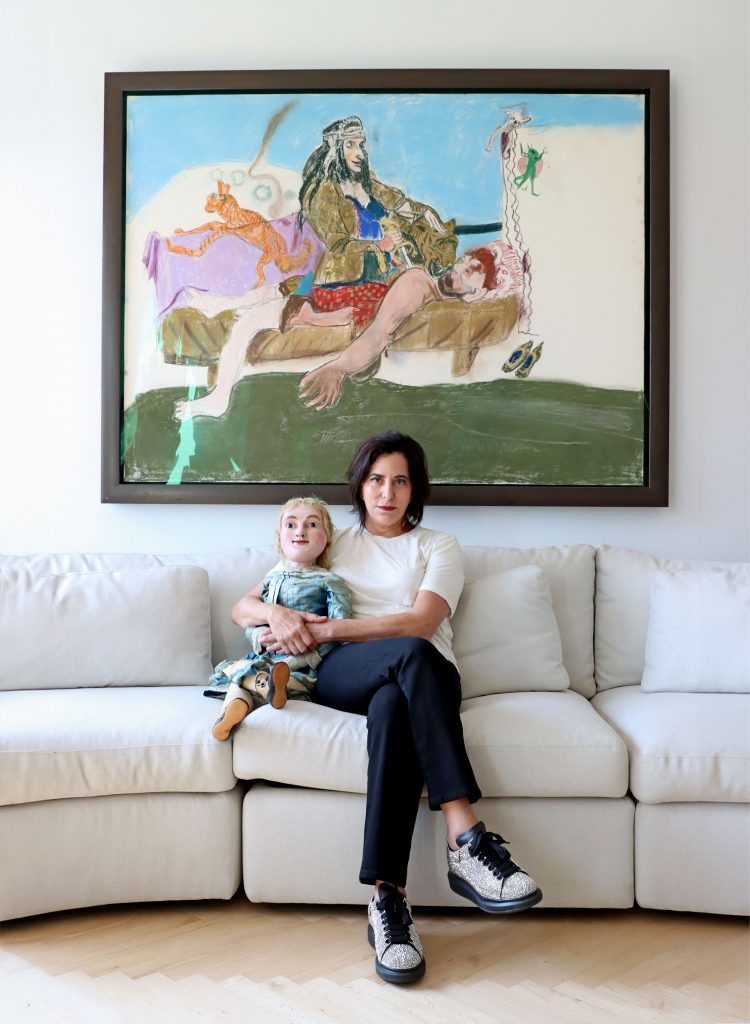
New York-based arts patron Kim Manocherian named her collection after Scheherazade, the heroine in One Thousand and One Nights who cleverly avoids death by never finishing the story she’s obliged to tell the brutish king each night. The story’s ending is always just one night away, making the tale of Scheherazade one of personal resolve and self-preservation.
They’re the same qualities that Manocherian recognized in the work of feminist artist Paula Rego, whom she asked to paint her portrait based on the 18th-century folktale. That project led to a lasting friendship between the women and resulted in Manocherian holding the largest private collection of the Portuguese-British artist in the world.
The Rego works form the core of the Scheherazade Collection, and mirror Manocherian’s closely held beliefs in the transformative and recuperative nature of art and female empowerment. “I see the influence of Rego,” she told Artnet, “in so many works in my collection—a love for the absurd, a celebration of the metamorphic properties of storytelling, and finding beauty despite great pain.”
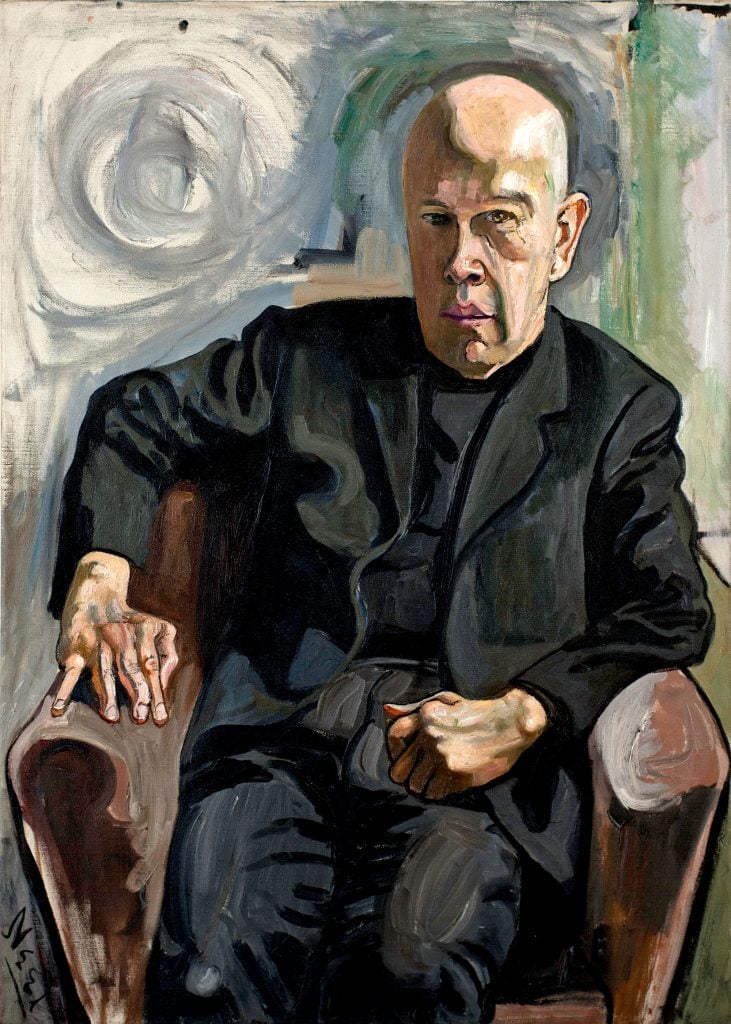
Alice Neel, Max White (1961). Courtesy of Kim Manocherian.
For 40 years, Manocherian has built an independent, irreverent collection that now numbers more than 600 works and spans emerging to well-known artists. Drawn to female narratives, the collector has acquired the likes of Mary Beth Edelson, a pioneer of feminist art in America, as well as Alice Neel, Louise Bourgeois, Anita Steckel, Sarah Lucas, and Janet Sobel, who’s thought to have invented drip painting before Jackson Pollock. Manocherian also supports contemporary artists Chantal Joffe and Firelei Báez, and holds a special place in her heart for self-trained women, among them Vanessa German and Iranian artist Mokarrameh Ghanbari, who only began painting at the age of 61.
Another point of pride for Manocherian is her practice of loaning works to institutions all over the world, including Tate Britain, the Musée de l’Orangerie in Paris, and the Louisiana Museum of Modern Art, Copenhagen. She has also donated to MoMa, Tate Britain, and the New York Historical Society. Prior to her life in art and quest for personal emancipation, she was the CEO of her family’s business, the New York Health and Racquet Club.
We caught up with Manocherian to discuss the enduring appeal of women artists and breaking free from the “straitjacket of society.”
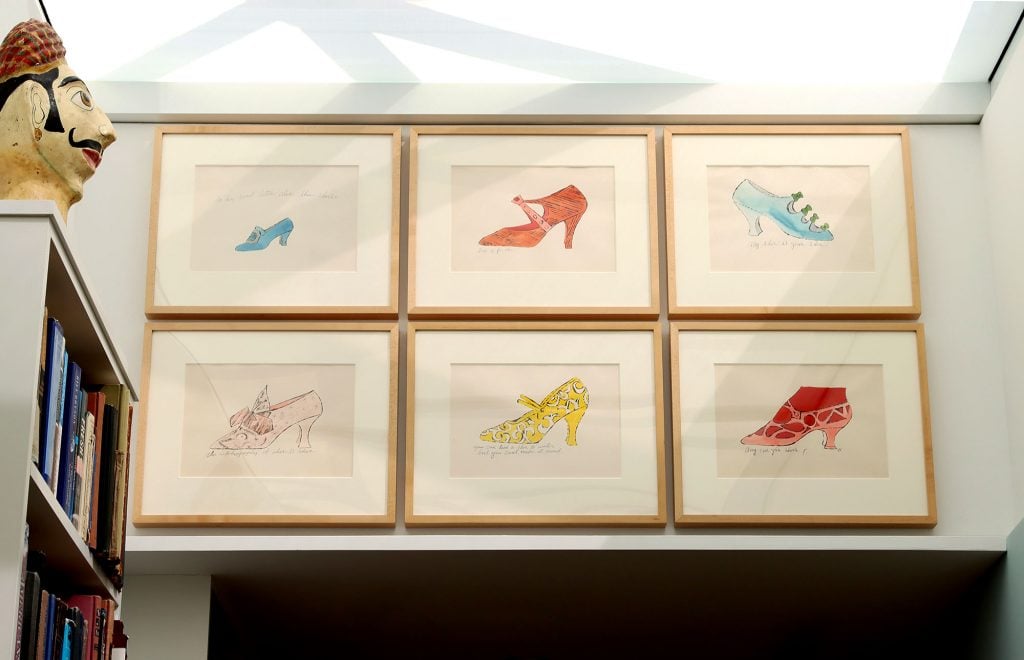
Six illustrations from Andy Warhol’s series of shoe drawings, acquired in 1982. Courtesy of Kim Manocherian.
What was your first purchase?
My first purchase was in 1992 and it was a portfolio of Andy Warhol shoes (hand-colored prints) from Susan Sheehan Gallery. I can’t tell you why I responded to them as they don’t have the same qualities of the art I collect today, but I still love them—something to do with the juxtaposition of color and the fact that it is a series. I have a love of fashion, and the way style can represent people. I still very much enjoy them.
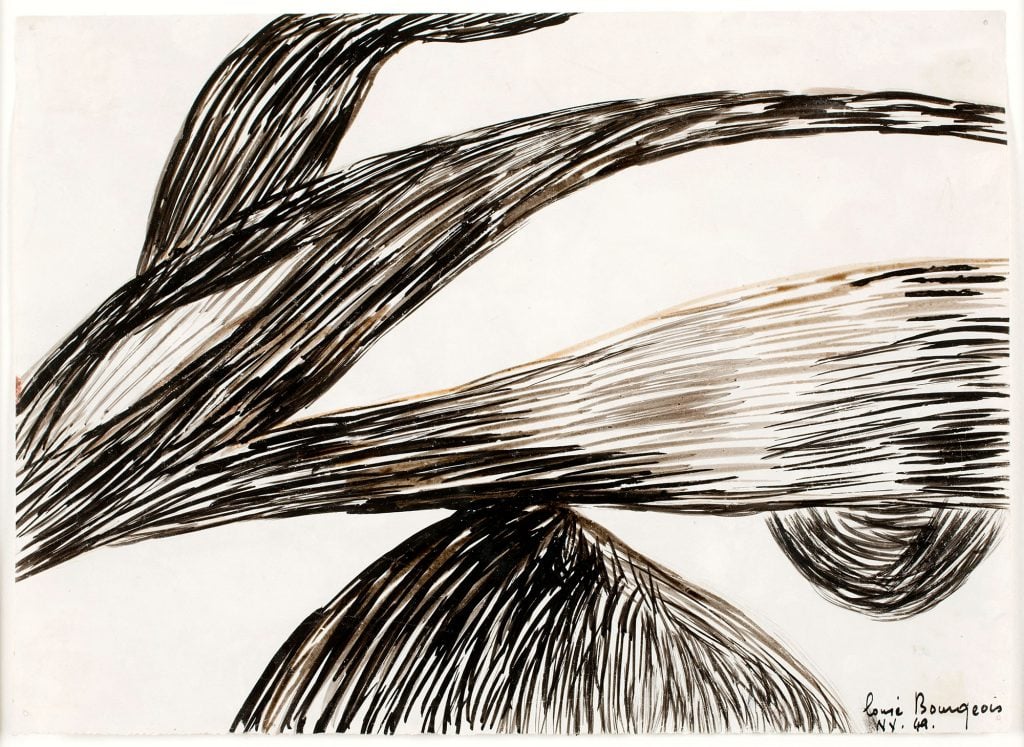
Louise Bourgeois, Untitled (1949). Ink on paper. Courtesy of Kim Manocherian.
You also own a lot of Louise Bourgeois drawings. How did that come to be?
The Louise Bourgeois drawings are as in sync with my collection as anything—an incredible feminist artist who was abused and created drawings that are very direct. Some other works may be harder to discern their place at first, but hers are very clear.
What was your most recent purchase?
Most recently I bought some of the most exciting works I have—two Kara Walker paintings.
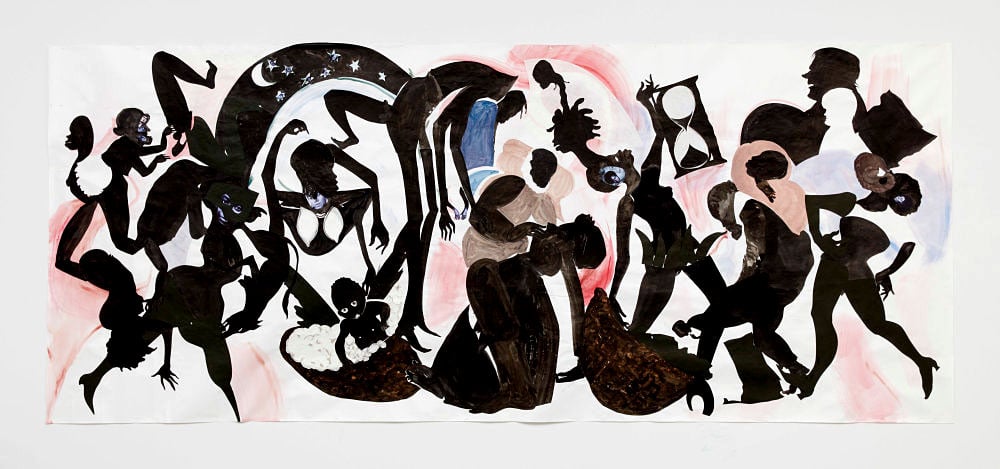
Kara Walker, Another Time Traveling Afro-Crone Bends Your Future to Rectify Her Past (2023). Courtesy of Kim Manocherian.
How has your collecting philosophy changed from the beginning to now?
I think when I started collecting, I was more cautious and, as a result, the work is not as true to me as what I buy now. I didn’t have the courage financially, or personally, to really go for it. I know now that art really is an important tool for empowerment and change; it can open people’s eyes to things they would rather ignore. I love that philosophy, and it’s empowered me to be more fearless and intuitive in my collecting.
Tell us about your collection of Paula Rego works. I’m told it’s the largest in the world.
I remember one day perusing a magazine and running into a photograph of one of Paula Rego’s works. It was 2011 and I didn’t understand how I could have missed her on my radar until then. A few days later, my mother went with me to London to meet with John Erle-Drax, who was then [senior director] at Marlborough London to see the two paintings they had available. To this day, I regret that I didn’t buy the one I really loved because it was “too much” for me at the time. The price of the two pieces were the same, but the image was, well, disturbing. I went for the safer one, and, after years of collecting Paula’s work, it is my least favorite of what I own of hers now.
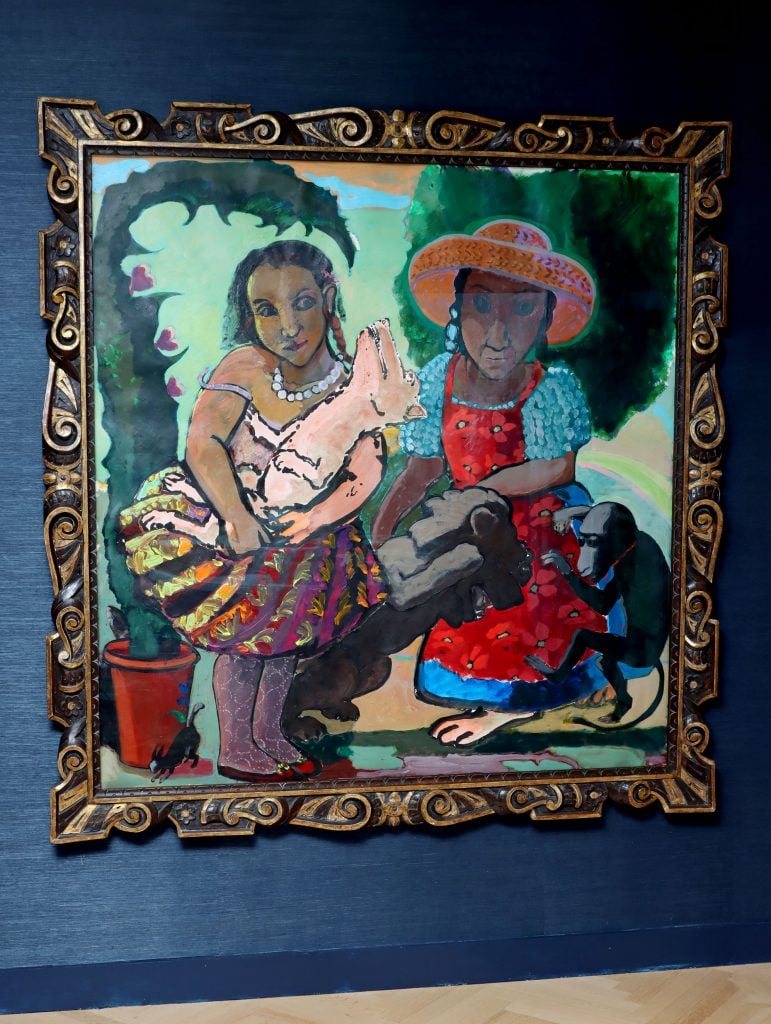
Paula Rego, In the Garden (1986). Courtesy of Kim Manocherian.
I am a person of extremes, and when I like something, I want to know everything about it. I had the privilege of meeting Paula through her gallery representative Frankie Rossi, who has since become a good friend. Frankie brought me to Paula’s studio, where I got to see her in her element, with all her dolls surrounding her, and met her muse, Lela, who is someone I also remain in touch with today. We ended the day with Paula’s favorite treat: champagne. I was flying high. I saw that she dressed her dolls in vintage clothing and, as one of my closest friends in the world, Doris, is the owner of one of the most iconic vintage stores in L.A., the Way We Wore, I reached out to Doris and she looked up Paula’s art and went to work to find clothing that would be relevant for her. For years, I brought and sent Paula vintage clothing. One of the pieces took up an entire suitcase and she wore it herself in one of my favorite photos of her.
This ongoing relationship with Paula allowed me to watch her work adapt and grow, and to holistically build a collection of works from across her oeuvre. It is true that I have the most Rego works in a single collection, and something that comes with it is a huge sense of responsibility for her legacy.
The character of Scheherazade, from One Thousand and One Nights, plays a role in your collection. Can you explain?
Again, it sort of begins with Paula. I asked Frankie (Rossi) if Paula would consider me to sit for her. Paula apparently didn’t understand why I would want to, but she agreed and asked me to think of my favorite fairy tale or story and I landed on the tale of Scheherazade. The story is about a woman who marries a king who has taken to killing his wives, each after one night. However, through her gift for incredible storytelling, he deigns to keep Scheherazade alive so he can hear the end of her tales. It’s a very abbreviated summary, but it seemed as close to my dream of how art might be used to replace or transcend pain and violence. In Paula’s version of the story, I stab the king. In the actual story, she reads to him and never ends the story. I like both endings.
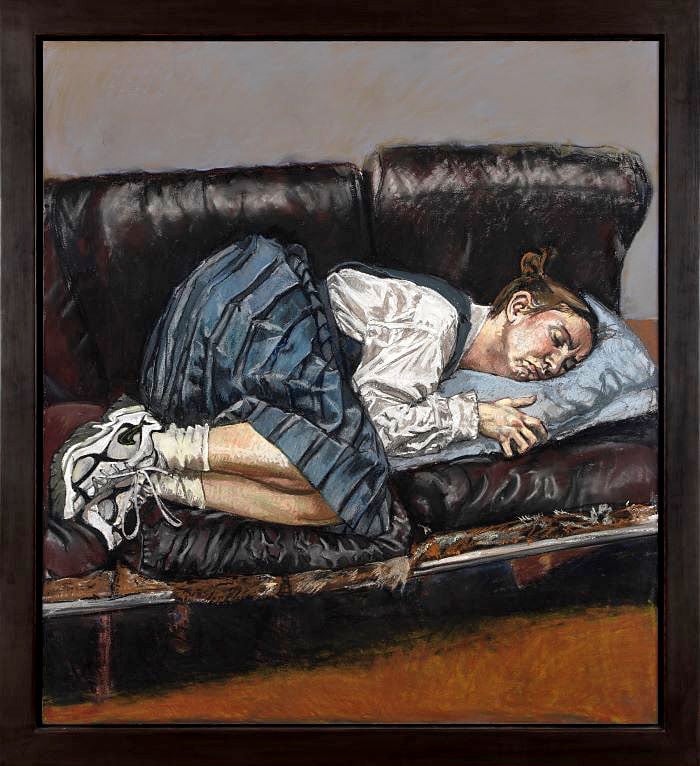
Paula Rego, Untitled No. 4 (1998). Courtesy of Kim Manocherian.
What is a favorite work in your collection?
It is hard to say what my favorite work is. If I could only choose a few pieces, it would be my kid’s artwork. To me, it’s really all about the sentiment, and the way the work makes me feel. Some speaks to my anger, some to my power, some make me smile. It depends on the day. It is always changing.
Where do you buy art most frequently?
I was in the service industry for years and I spent a lot of time thinking about life’s meaning and my purpose. I love to meet artists because I feel they are sharing with me a piece of themselves, and I want them to know it is cherished and I will do what I can to push the work forward. I have had the privilege of having a wonderful relationship with artists like Paula Rego and, as I said, I am in touch with John and Frankie from her previous gallery, her muse Lela, her son Nick Willing, as well as, of course, her current gallery Victoria Miro.

Barbara Kruger, Untitled (Our prices are insane!) (1987). Courtesy of Kim Manocherian.
Art is a relationship to me, so I go where the relationships are. I adore Robert Manley from Phillips so I recently bought an amazing Barbara Kruger from there. I had a wonderful relationship with Frank Demaegd at Zeno X and trusted Frank implicitly. I bought a lot of work from Frank over the years. Meg Malloy at Sikkema Jenkins and Cecile at Sean Kelly. I work with the people I trust and like. If I have a bad experience with a gallery or an artist, I can no longer feel good about the work and that is the only time I might sell a work. That, and when I change, and the work no longer resonates for me.

Left: Jeffrey Gibson, Homma 2013). Right: Jeffrey Gibson, Figure No. 3 (2014). Courtesy of Kim Manocherian.
I understand you frequently loan out to museums. What has been a personally gratifying loan you’ve made?
Every loan is personally gratifying to me—art needs to be seen. Collectors are stewards of artists’ work and need to work like a gallery to push the artist’s work forward. I have tried my best to help many artists who I felt showed tremendous promise and needed support in the beginning.
Currently I am very enthusiastic about an emerging artist who is not yet with a gallery, Dragan Strukelj. I will not buy his work until he is represented. I believe it is in the artists best interest to be with a gallery that will push the work forward. I have lent a room in my home for years to a few artists to use as a studio. I believe art is for sharing. Galleries should not just be places that sell art; galleries need to walk a very tight line of selling the work and making sure the work is sold to a collector who will serve the artist. They need to work with museums and the endless fairs. It is not as easy as people might think if it is done with integrity.
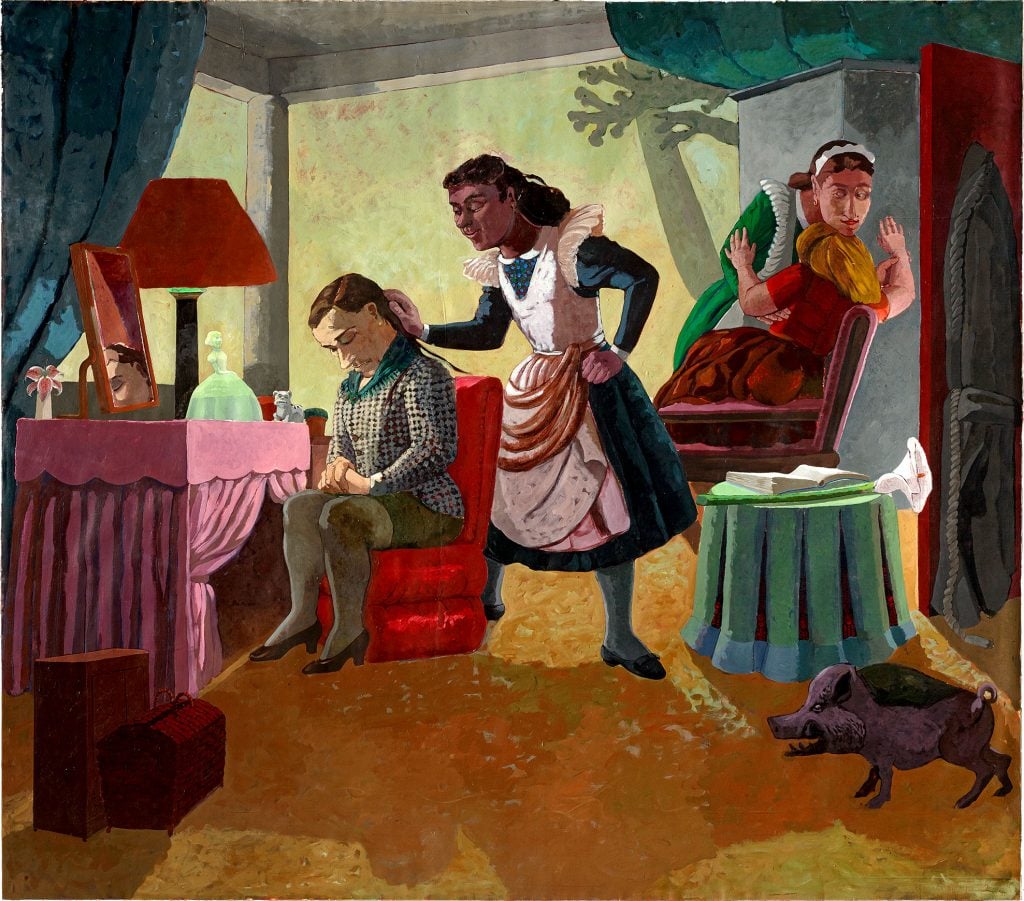
Paula Rego, The Maids (1987). Courtesy of Kim Manocherian.
What work do you have hanging above your sofa?
Scheherazade hangs above my sofa right now. But when I finally can figure out how to get Paula Rego’s The Maids into my apartment (crane involved), that will hang above my sofa. But the work moves around a lot.
Your collection has been described as irreverent. What would you say is your most irreverent piece?
Irreverence is breaking with the past, with tradition, with the straitjacket of society. Irreverence is seeing and sharing a larger truth than the current one. Irreverence is being true to something sacred inside, not acceptable (yet) to the world.
I am not sure why truth is irreverent. I have pieces depicting the feeling of loss after an abortion, and female circumcision. I have pieces from artists that were abused and paint their story. There is trauma, female power. I have a video installation of Persian women singing without sound called Listen. That is a reality, why is it irreverent? The Kara Walker I just bought is very beautiful while depicting images of the horrors done to slaves.
I live for humor, so I have a piece I find hysterical by Nicolas Darrot of a naked figure, chanting and going wildly insane in his chanting. People find it strange. I find it very funny, and it reminds me of my inability to “meditate.” I am not very good at sitting still.
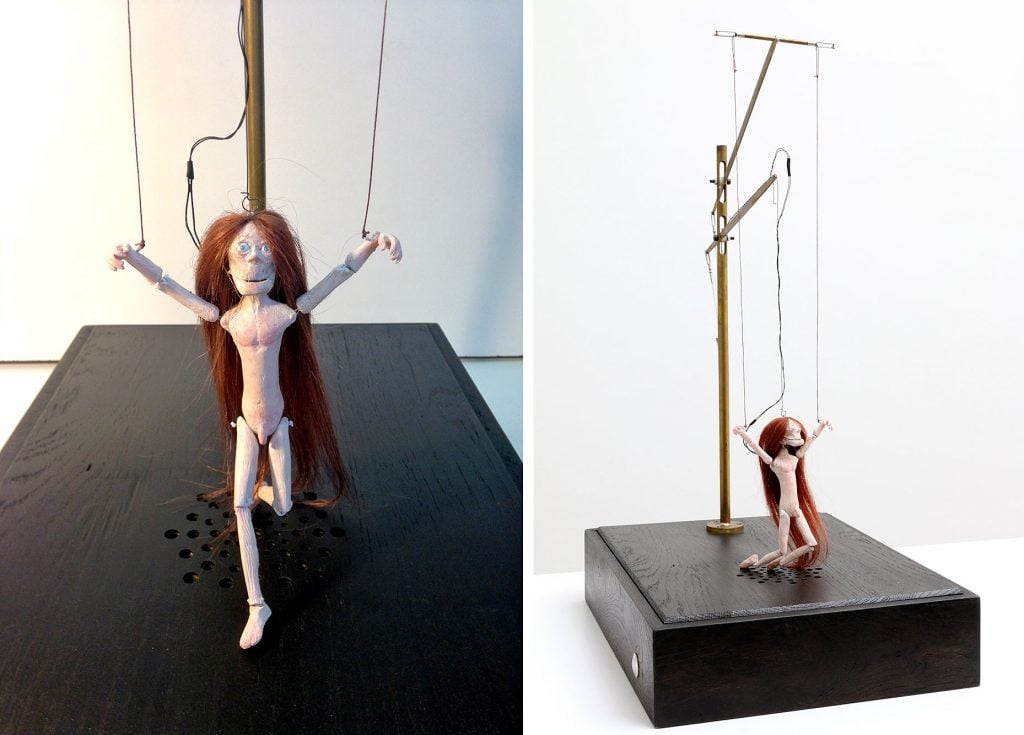
Nicolas Darrot, Shaman with red hair (2012). Courtesy of Kim Manocherian.
What work do you wish you had bought when you had the chance?
There is one Paula Rego work that I desperately wanted, and it came up in auction but went for a price I couldn’t justify. Years later, it came up again and the same thing happened. I wish I had the work, but I never want to look at a work and think of the price instead of the work, so, I just keep a picture of it close by and look at the picture and that is okay. Not the same, but it works for now.
Which works or artists are you hoping to add to your collection this year?
I would love to have a Marlene Dumas, Dana Schutz, and Tracey Emin. And maybe, I will one day. But for now, I love what works I am surrounded by and excited about the Kara Walker entering my life because I think she is one of the most courageous, talented artists of today.
If you could steal one work of art without getting caught, what would it be and why?
Perhaps one of Dorothea Tanning’s figurative paintings. That opens up so many things I would want. Gaugin wouldn’t be bad; some of Lucien Freud’s smaller work. More Kara Walker. Obviously, Marlene Dumas and Dana Schutz. I could go on and on. When I see work that speaks to me, my heart beats faster. I get so excited. It is not always received with delight. I can be persistent to a point of annoyance and I can be over enthusiastic potentially. But it is genuine.





